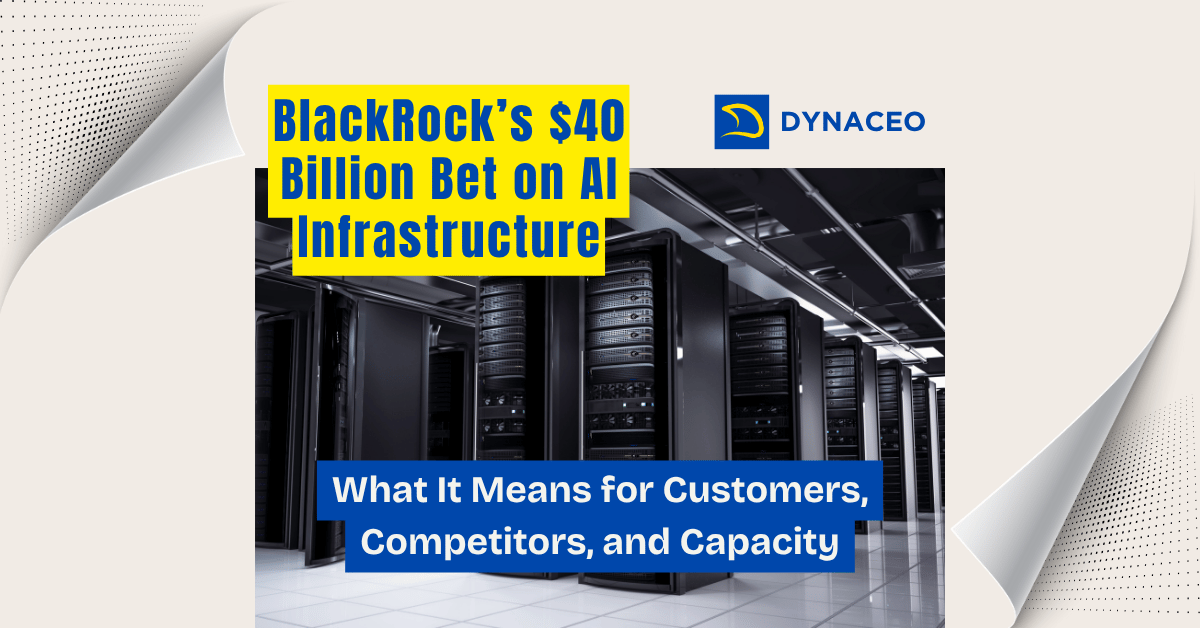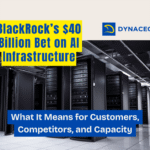At A Glance:
- The big picture: BlackRock’s GIP is nearing a $40B deal for Aligned Data Centers, aiming to control land, power, cooling, and rapid campus build capacity at the heart of AI growth.
- Why it matters: Data centers now function like core infrastructure with long-term, inflation-indexed contracts; power and grid interconnects are the primary scaling bottlenecks.
- Who benefits most: Hyperscalers and AI/HPC platforms that can pre-commit multi-megawatt blocks and densify GPU deployments on accelerated timelines.
- Who feels pressure: Mid-to-large enterprise colocation tenants seeking incremental capacity in tier-1 metros without hyperscale-level commitments; expect tighter allocation and firmer pricing.
- Not primary targets: Retail registrars and shared/VPS hosters (e.g., GoDaddy, Namecheap). Any impact is indirect via pricing and power-density policies at retail/wholesale colos.
- Illustrative exposure: CDNs (Cloudflare, Fastly, Akamai), gaming (Riot, Roblox, Epic), MSPs (Rackspace, INAP, TierPoint), payments (PayPal, FIS, Fiserv), market data (Bloomberg, Refinitiv).
- C-suite actions: Lock in capacity earlier, prepare for liquid/hybrid cooling, diversify metro footprints, use inflation-indexed contracts, and fortify equipment supply chains.
Contents
- 1 Implications for Customers, Capacity, and Competition
- 2 The Strategic Context: Infrastructure, Not Just Real Estate
- 3 Customer Landscape: Who Aligned Serves and Where
- 4 Clarifying Key Terms: Hyperscalers and AI/HPC Tenants
- 5 How Aligned Fits: What the Platform Delivers
- 6 Impact Analysis: Who Benefits and Who Feels Pressure
- 7 Company Examples: Illustrative Exposure
- 8 Is This a Tech Strategy Pivot? Viewing It Through Infrastructure
- 9 What C‑Suites Should Do Now
- 10 The Bottom Line
Implications for Customers, Capacity, and Competition
BlackRock’s Global Infrastructure Partners (GIP) is reportedly nearing a $40 billion acquisition of Aligned Data Centers. This transaction underscores a strategic push to own the scarce inputs of the AI economy—land, power, cooling, and rapid build capacity—rather than the application or software layer. The immediate beneficiaries will be hyperscalers and AI/HPC platforms that can pre‑commit multi‑megawatt blocks under long‑term, inflation‑indexed contracts. The most pressured segment will be mid‑to‑large enterprise colocation tenants competing for power‑rich space in tier‑1 metros without hyperscale‑level commitments.
The Strategic Context: Infrastructure, Not Just Real Estate
Why data centers increasingly resemble core infrastructure
AI has transformed hyperscale data centers from “specialized real estate” into essential infrastructure with utility‑style economics. Scarce grid interconnects, multi‑gigawatt power needs, advanced cooling (air/liquid or hybrid), and long‑duration capacity contracts make campus delivery the critical path for digital growth. For BlackRock via GIP, this deal aligns with an infrastructure mandate: deploy capital into durable, cash‑generating assets central to economic activity.
What BlackRock aims to control
- BlackRock aims to control power‑rich hyperscale campuses that anchor AI growth, because adjacency to substations and access to long‑lead grid interconnects has become the key constraint on scaling compute.
- BlackRock seeks to control high‑density environments optimized for GPUs and accelerators, where rapid densification and advanced cooling materially improve utilization and economics for anchor tenants.
- BlackRock intends to control land, fiber adjacency, and expansion rights across tier‑1 and fast‑growing metros, consolidating capacity where the largest AI workloads deploy first.
Customer Landscape: Who Aligned Serves and Where
Footprint versus reach
Aligned markets to global customers but operates its owned and managed facilities across the Americas—principally in the United States, with expansion across Latin America and Canada. Its platform emphasizes build‑to‑scale and powered‑shell offerings for hyperscalers, AI/HPC, and large enterprises, prioritizing high‑density, rapid time‑to‑power delivery.
Core customer segments
Aligned’s core customers are global hyperscalers and AI/HPC tenants that pre‑lease multi‑megawatt capacity, prefer long‑term contracts, and require rapid timelines and densification. Aligned also serves large enterprises with high‑density needs and sustainability priorities, though campus allocation typically tracks anchor‑tenant scale and multi‑MW commitments. Aligned does not primarily target retail colocation users (for example, shared/VPS hosting brands and registrars). Those customers typically lease racks or cages in retail/wholesale colocation operated by providers such as Equinix or Digital Realty.
Clarifying Key Terms: Hyperscalers and AI/HPC Tenants
What hyperscalers are
Hyperscalers are very large cloud platforms that operate global, highly automated data centers and deliver compute, storage, and networking at enormous scale. They build and run multi‑region infrastructure with elastic capacity and sophisticated orchestration to serve millions of users and services. In practice, hyperscalers provide the platform on which many workloads run.
What AI/HPC tenants are
AI/HPC tenants are organizations or teams that rent or contract for infrastructure (in hyperscale cloud or colocation) to run extremely compute‑intensive workloads. AI tenants focus on training and serving large models on GPU/accelerator clusters; HPC tenants run scientific or engineering simulations and parallel computations on high‑performance CPU/GPU nodes with fast interconnects. In practice, AI/HPC tenants consume the platform for large‑scale training, inference, and simulations requiring high throughput, low latency, and specialized hardware.
Examples
- Hyperscalers include AWS, Microsoft Azure, Google Cloud, Oracle Cloud, Alibaba Cloud, and IBM Cloud.
- AI/HPC tenants include OpenAI, Anthropic, xAI, Meta AI, Cohere, Stability AI, and Mistral; national labs and research organizations such as NASA, CERN, Oak Ridge National Laboratory, and Los Alamos; university HPC centers; and industry HPC users such as Shell, Boeing, Siemens, and pharmaceutical companies (for example, Novartis).
How Aligned Fits: What the Platform Delivers
Campus‑scale, AI‑ready infrastructure
Aligned builds and operates hyperscale and gigascale campuses with build‑to‑scale options, powered shells, and single‑tenant/multi‑building configurations. The design focus is high‑density (including air/liquid or hybrid cooling), rapid time‑to‑power, renewable load‑matching, and operational efficiency for GPU‑dense clusters. Hyperscalers typically lease large footprints and install their own servers, accelerators, storage, and high‑speed networking. Many AI/HPC tenants consume compute from those hyperscalers rather than installing hardware directly, though some pursue colocation or bare‑metal deployments.
Impact Analysis: Who Benefits and Who Feels Pressure
Biggest beneficiaries
- Hyperscalers and AI/HPC platforms will benefit the most from deep‑pocketed ownership, which de‑risks grid interconnects, accelerates land assembly, stabilizes supply chains (transformers, switchgear, cooling systems), and enables larger pre‑leases with faster densification for GPU‑heavy workloads.
- Latency‑sensitive global firms that can commit multi‑megawatt footprints will be secondary beneficiaries, gaining improved regional coverage and redundancy as campuses open or expand across the Americas.
Impact on biggest beneficiaries
- Capacity scarcity and pricing power: With grid interconnection queues and power constraints delaying new builds, controlling a large, AI-ready portfolio gives BlackRock/GIP leverage. Competitors may face tighter access to power and longer lead times, supporting higher lease rates and stricter power reservation terms in constrained metros (Northern Virginia, Phoenix, Dallas, Columbus).
- Consolidation pressure: A $40B platform raises the bar on scale and financing. Expect follow-on M&A among second-tier operators and potentially defensive moves by large platforms to secure campuses, substation capacity, and liquid-cooling capabilities.
- Hyperscaler supply dynamics: Hyperscalers could benefit from accelerated delivery if GIP scales Aligned’s $12B financing into faster builds—but in power-tight regions, the owner may command premiums and longer commitments. Net effect varies by market and timing.
- Technology and sustainability differentiation: Aligned emphasizes efficient cooling (including zero-water approaches) and load-matched renewables. Providers behind on liquid cooling, high-density designs (20–300 kW/rack), and sustainable power matching may lose AI workloads or margin as tenants prioritize density and ESG claims .
- Portfolio synergies: If GIP pairs Aligned with CyrusOne, it could create one of the largest hyperscale platforms globally, concentrating procurement, design standards, and customer relationships—raising competitive pressure on peers in site selection and cost per MW.
Most affected segments
- Mid‑to‑large enterprise colocation customers seeking incremental capacity in tier‑1 metros without multi‑MW commitments will be most affected. They will face tighter allocation, firmer pricing, and longer lead times as operators prioritize hyperscale AI deployments in power‑constrained markets.
- Managed hosting and multi‑tenant service providers may encounter more standardized underwriting and less bespoke build flexibility, reflecting infrastructure‑style campus economics.
Not the most affected: retail registrars and shared/VPS hosters
- Brands such as GoDaddy, BlueHost, SiteGround, Namecheap, NameHero, LiquidWeb, and MochaHost are unlikely to be directly affected. They typically lease in retail/wholesale colocation facilities and operate their own servers, rather than occupying hyperscale campuses.
- Any impact for these brands will be indirect, via pricing firmness, power‑density policies, or longer expansion lead times at the retail/wholesale colos they use in constrained metros such as Northern Virginia, Phoenix, Dallas, and Chicago.
Near-term vs. longer-term effects
Near term: Pricing firming and pre-leasing competition rise in key U.S. corridors; some providers face delays securing utility feeds and transformers, pushing customers toward platforms with secured power and shovel-ready sites .
Longer term: More sovereign and infrastructure capital likely enters AI data centers, lifting valuations and accelerating build-outs; retail colocation players adapt with liquid cooling, campus-scale power procurement, and strategic partnerships to avoid being outbid for grid capacity
Company Examples: Illustrative Exposure
- Content delivery networks and edge platforms—such as Cloudflare, Fastly, and Akamai—could see tighter expansion windows or higher costs where AI deployments crowd out capacity in tier‑1 hubs.
- Online gaming platforms—such as Riot Games, Roblox, and Epic Games—may experience crowd‑out risks in metro hubs, as they tend to scale via racks and cages rather than multi‑megawatt blocks.
- Managed hosting and MSPs—such as Rackspace Technology, INAP, and TierPoint—could face longer lead times and firmer pricing for incremental growth when campuses prioritize hyperscale AI tenants.
- Payments and fintech connectivity hubs—such as PayPal, FIS, and Fiserv—may encounter constrained capacity and higher costs in key carrier hotels and exchange‑adjacent metros that affect deployment flexibility.
- Market data and financial platforms—such as Bloomberg and Thomson Reuters (Refinitiv)—rely on colo presence near exchanges; capacity tightness can raise costs and reduce options in those hubs.
Is This a Tech Strategy Pivot? Viewing It Through Infrastructure
This move is best viewed as infrastructure consolidation, not a shift into application‑layer technology. AI compute economics—massive power draw, high‑density cooling, long‑lead grid connections, and multi‑year capacity commitments—push data centers into an infrastructure asset class with defensive, inflation‑resilient cash flows.
Portfolio synergies may lower cost per megawatt, standardize campus delivery, and provide financing advantages that speed time‑to‑market and support larger pre‑leases. Execution risks remain (grid lead times, permitting, equipment supply, and community/environmental considerations), and potential co‑investment by sovereign or strategic capital may shape governance and returns.
What C‑Suites Should Do Now
- Leaders should reassess metro strategy and capacity planning in tier‑1 hubs to mitigate crowd‑out risk, securing space and power earlier through longer‑term, multi‑MW commitments where feasible.
- Leaders should evaluate densification readiness—including liquid/hybrid cooling—to align with emerging campus standards favored by infrastructure investors.
- Leaders should diversify footprints across adjacent metros with available interconnects, balancing latency needs against capacity accessibility.
- Leaders should re‑examine contract structures for inflation indexing, power‑availability clauses, and pre‑lease options that improve predictability and resilience.
- Leaders should strengthen vendor and equipment supply strategies (transformers, switchgear, chillers) to mitigate hardware bottlenecks that can delay deployments.
The Bottom Line
BlackRock’s proposed acquisition of Aligned Data Centers is a bet on owning the scarce physical inputs of AI. It advantages customers capable of multi‑megawatt, GPU‑dense commitments under infrastructure‑style contracts and pressures mid‑to‑large enterprise colocation tenants competing for constrained capacity. Over the next decade, competitive advantage will hinge not only on model innovation but also on securing the land, power, and cooling required to run those models at scale.
Additional Reading:
- Bloomberg coverage of GIP/BlackRock in advanced talks to acquire Aligned Data Centers at about $40 billion.
- Aligned’s positioning, build‑to‑scale offerings, and AI‑ready design focus.
- Aligned’s Americas footprint and campus development across North and South America and Canada.
- Financing and capacity expansion (>$12B commitments; 5+ GW current/planned).
- McKinsey: Infrastructure demand and constraints for AI/data centers.
- U.S. Data Center Colocation Market Report 2025-2030 Featuring Key DC Investors.
- Reuters sources say GIP in talks to buy Aligned Data Centers.
- Yahoo Finance tags Bloomberg article about GIPs late stage talks to acquire ADS.








